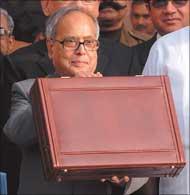The finance ministry's Budget Manual has ended the aura of secrecy around the preparation of the annual Budget, according to A K Bhattacharya.
Last month, the Union finance ministry released the Budget Manual. A 216-page document, it contains all the procedures and steps the government must follow while preparing the annual Budget. It is a unique document.
No other ministry has ever tried to bring out in the open the procedures it follows before finalising, for instance, the foreign trade policy or the central and state plans. Finance ministry officials responsible for preparing the Budget Manual, therefore, should feel proud of what they have achieved.
Finance ministry officials responsible for preparing the Budget Manual, therefore, should feel proud of what they have achieved.
That it took 63 years for the government to come out with a comprehensive document like this is also a comment on the way the bureaucracy functions in India. Why didn't anyone else in the government system in the past so many years think of producing as basic a document as this?
The answer may lie in the government's belief that the Budget procedures should remain shrouded in secrecy.
Thus, various Budget-related instructions and guidelines were available in the form of executive orders and circulars in different files in the Budget Division of North Block, the headquarters of the finance ministry. However, nobody made an effort to put them together.
The idea of bringing out all these circulars and procedures in a single document and then making that public is, therefore, truly revolutionary. The net result of the exercise is that the Budget process has become transparent. This has also made simpler and less onerous the task of new officers joining the Budget Division of the finance ministry or, for that matter, any other ministry connected with the formulation of the Budget.
How elaborate is the annual Budget exercise? The Budget Manual lists as many as 37 specific steps that the finance ministry has to complete between the second week of September, when the Budget circular is out marking the start of the annual exercise, and the last working day of February the following year, when the finance minister presents the Budget in Parliament.
Once the Budget becomes the property of Parliament, the government must follow a different schedule, according to the Manual. Between the first week of March and the first week of May, the government has to ensure the completion of 25 more specific action points.
These steps are required to get the various Budget-related Bills passed. For instance, the government has to get two appropriation Bills passed. One of these Bills proposes to allow the government to draw money from the Consolidated Fund of India until Parliament passes the full Budget and the other, after its passage, allows the government to draw money from the exchequer for the remaining months of the year.
In addition, the finance ministry has to get Parliamentary approval of the various demands for grants pertaining to the central ministries, the general discussion on the Budget and most importantly the Finance Bill, which contains all the legislative changes to give effect to the new tax rates and procedures.
The target for obtaining the president's assent to the Appropriation Bill and the Finance Bill is the first week of May, which marks the end of the annual Budget exercise.
In other words, the Budget exercise takes over seven months and three weeks in a year. The finance ministry may well ponder if it indeed needs such a long drawn-out schedule for the preparation of the annual Budget, now that tax rates have become more stable and the Budget is more about setting the government's expenditure priorities.
An interesting aspect of the Budget exercise is that about a week before the actual presentation, the finance ministry finalises the Finance Bill and sends it for printing.
In other words, the finance ministry concludes its deliberations on tax rate changes or modifications in the provisions of the tax policy about a week before the Budget becomes public. The finance minister can still make some changes in non-tax-related matters as he finalises his speech just three days prior to presenting the Budget.
The three days before the Budget are indeed tense for the finance minister and his team of officials involved in the Budget exercise. While those in the Budget printing press in North Block remain locked inside the premises until the Budget is presented in Parliament, the officials in Budget Division prepare a summary of the Budget for the Cabinet. This is done two days before the Budget is due to be presented in Parliament.
On the day the Budget is presented, three other significant events take place. One, the prime minister gives his approval to the finance ministry's request that the Budget Summary be presented to the president. Two, the president recommends under Articles 112, 115 and 117 of the Constitution that the government may present its annual financial statement to Parliament. Three, the Cabinet meets and approves the Budget.
The surprise element in Budgets during the post-reforms era has seen a progressive decline, with tax rates remaining largely stable and fewer sector-specific exemptions or concessions.
Now, the Budget Manual has put an end to the mystique and aura of secrecy around the procedures for preparing the government's annual financial statement.